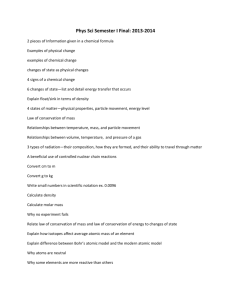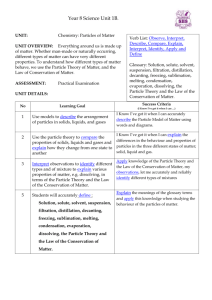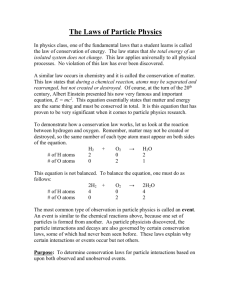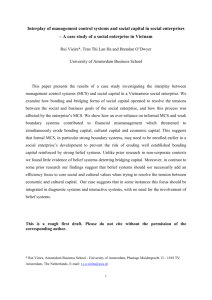Momentum and energy conservation in particle physics (Blair high
advertisement
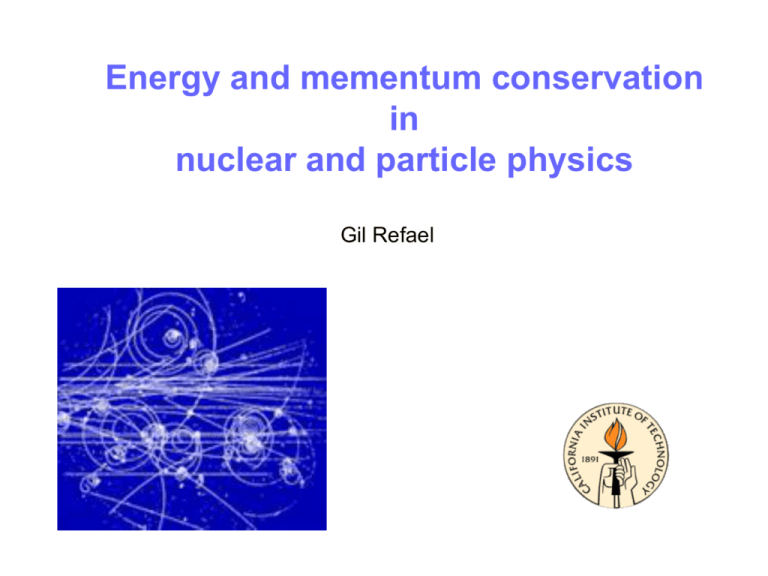
Energy and mementum conservation in nuclear and particle physics Gil Refael Conservation laws: Momentum conservation: m1v1 m2v2 m1v1 'm2v2 ' Energy conservation: 1 2 1 2 1 2 1 2 m1v1 m2 v2 m1v1 ' m2 v2 ' 2 2 2 2 (Elastic collision) 1 2 Conservation laws: Momentum conservation: m1v1 m2v2 m1v1 'm2v2 ' Energy conservation: 1 2 1 2 1 2 1 2 m1v1 m2 v2 m1v1 ' m2 v2 ' 2 2 2 2 (Elastic collision) 1 2 Conservation laws: Momentum conservation: m1v1 m2v2 (m1 m2 )v ' Energy conservation: 2 1 2 1 2 1 m1v1 m2 v2 (m1 m2 )v ' Eheating deformation 2 2 2 (inelastic collision) 1 1 2 2 ‘Explosion type’ collision 1 2 Momentum conservation: m1v1 m2v2 0 Energy conservation: 1 2 1 2 m1v1 m2 v2 Estored 2 2 Radioactivity Radioactivity and Elementary particles Thorium Uranium (238): m p mN 1840 me 92 protons + + + 146 neutrons + + + + + Very crowded! Radioactive “alpha” decay + + + + + + + + Alpha particle =Helium nuclei Uranium Decay Thorium (234) Uranium (238) + + + + + + + + Momentum conservation: Alpha (4) + Energy conservation: mTh vTh m v 0 What is Estored ? + + + + (half time: 4.46 billion years) 2 1 2 1 mTh vTh m v Estored 2 2 Clue: Some mass disappears in the transition! mTh m mU 8me 8 electron masses missing! c=speed of light=300,000,000 m/s Estored M missing c 2 Another example: Plutonium (half time: 24,100 years) Uranium (235) Plutonium (239) + + + + + + + + + + + + + What is Estored ? mU m mPu 11me Estored M missing c 2 c=speed of light=300,000,000 m/s What is the recoil speed? Alpha (4) Uses of Uranium and Plutonium Uranium (235): • Fuel for nuclear reactors. Uranium (238): • Fuel for nuclear reactors. • Plutonium (239) production. Plutonium (239): • Fuel for nuclear reactors. • Nuclear weapons… Elementary particles: Neutron decay Just like Uranium, the neutron itself (outside a nucleaus) is also unstable: e N + mN 1839 me mN 1836 me me me mP me mN 2me Estored M missing c 2me c 2 2 meve mP vP 0 1 2 1 2 mP vP me ve 2me c 2 2 2 Expect: electrons have the same energy in the end of the process. But: Every experiment gave a different result! Neutron decay Just like Uranium, the neutron itself (outside a nucleaus) is also unstable: e N mN 1836 me + mN 1839 me me me What about momentum and energy conservation ?!? Answer: There must be another particle! Neutrino Very light particle, that can go unscattered Through the entire galaxy! How was this measured? Bubble chambers X Magnetic Field X X Liquid Hydrogen on the verge of becoming gas. Particles leave trail of bubbles! How was this measured? Bubble chambers X e Magnetic Field X X X Neutron (0) X X + Proton (+1) p mv qB r Radius proportional to momentum Aurora Borealis – aka, Northern Lights Fairbanks, Alaska: © Jack Finch—Science Photo Library/Photo Researchers, Inc. Aurora Borealis – aka, Northern Lights Kangerlussuaq, Greenland’s west coast: (www.greenlandholiday.com) Aurora Borealis – aka, Northern Lights Fast particles from the sun: + Proton (+1) The particle hunters How to produce new particles like the neutrino? Make very energetic collisions between them! This happen in particle accelerators: Electrons are accelerated up to near the speed of light! Monster accelerators Fermilab in Chicago: Monster accelerators Cern in Geneva: Elementary particles – Quarks and Leptons So far: • Protons (+1) • Neutrons (0) • Electrons (-1) + But also: Neutrinos. N e Proton itself consists of quarks: up +up d up - “up” quark (charge: +2/3) d - “down” quark (charge: -1/3) Neutron: More quarks: (!) up Nd d To discover new quarks and other elementary particles: Need energy of: ELHC ~ 107 me 10,000,000me !!! Right now searching for: The Higgs “The particle that gives all particles their masses…”



